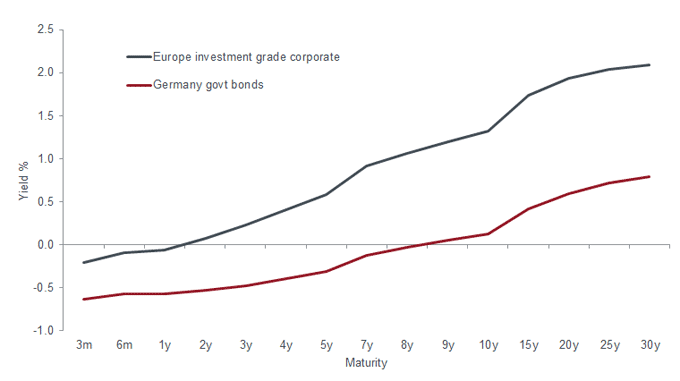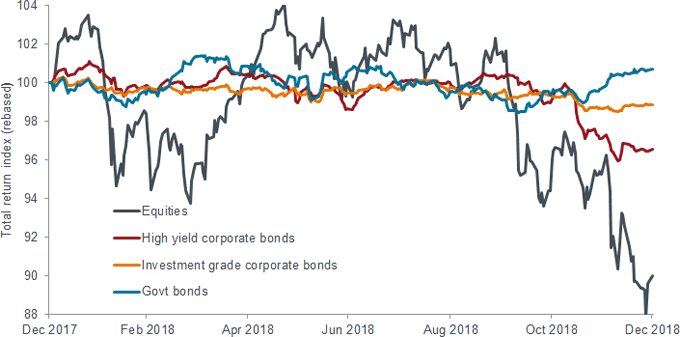Subscribe
Sign up for timely perspectives delivered to your inbox.
Nick Maroutsos, Co-Head of Global Bonds, explains why bonds offer potentially attractive qualities for income-focused investors worried about rising equity market volatility.
Perhaps simply ‘queasiness’ is more fitting. Certainly that is an apt feeling among investors who stomached sharp falls in risk asset prices in the last quarter of 2018, again bringing into sharp focus the question of asset allocation as investors consider the path ahead.
While some of the falls have reversed in early 2019, it is important to consider what may have driven the sharp declines and question whether they are symptomatic of a more prolonged malaise or a temporary setback. While this is impossible to answer with certainty it is hard to ignore the secular shift in the comparable risk/reward metrics of major asset groups, driven by changes in macroeconomic dynamics and an ever fluid political backdrop.
Equity markets have barely missed a beat while rewarding investors for much of the post-Global Financial Crisis environment, buoyed by central bank monetary stimulus. The combination of a stable tiller and cheap money is an intoxicating mix. But now, perhaps if the initial US experience is anything to go by, we are seeing for the first time in a long while the impact of having ‘the training wheels off’, of borrowing costs moving back to a more normalised level, on a jittery equity market.
What we are faced with today is a shifting set of relative market dynamics combined with a much less certain political landscape, with neither being ‘equity friendly’.
One thing that is arguably different in 2019 is the risk premium or simply the forecast return spread between cash and bonds, and equities. The sub 1% cash rate environment of the past decade was utopia for equities: dividend yields of 3-4% easily making them the darling of any asset allocator’s tool kit. But now that cash rates in the US have exceeded 2% the cost of doing business has changed markedly and the equity dividend yield return spread is less attractive. And that is before we factor in the higher sovereign and credit yields. Sure, there can be some pain to wear on the way up if duration exposure is left unhedged, but the forward-looking potential returns from fixed income asset classes today look a whole lot more appealing, with US 10-year Treasuries above 2.5%, and US investment grade credit yields comfortably above 4% at the medium-to-long end of the curve*. Suddenly an equity dividend yield of 3-4% doesn’t feel quite as rich. And almost certainly not on a risk- or volatility-adjusted basis.
Within Europe, the yield on European investment grade is not as generous as the US at an absolute level but when set against negative rates and low yields on Europe’s equivalent of the US Treasury – the German bund – there is a pickup to be had. Here, selectivity can offer incremental income without assuming excessive default risk.
 Source: Bloomberg, Bloomberg Europe Corporate Investment Grade BVAL yield curve, Bloomberg Germany Govt Bills and Bonds BVAL yield curve, 28 February 2019. Yield shown is yield to maturity.[/caption]
Source: Bloomberg, Bloomberg Europe Corporate Investment Grade BVAL yield curve, Bloomberg Germany Govt Bills and Bonds BVAL yield curve, 28 February 2019. Yield shown is yield to maturity.[/caption]
What is more, given the global economic slowdown and the US Federal Reserve shifting its rhetoric on monetary policy, openly discussing the possibility of pausing its balance sheet reduction, it is hard to see the European Central Bank embarking on quantitative tightening in the near term. For now, therefore, we must work within the confines of a low yield environment.
The low yields are symptomatic of a fragile economic backdrop. After all the noise of 2018, it concluded with those carrying the most defensive strategic asset allocations victorious, and serving as a worthy reminder that through cycles there will always be periods where it pays to bias your objectives towards not losing money just as much as making more.
 Source: Thomson Reuters Datastream, 31 December 2017 to 31 December 2018, MSCI Europe, ICE BofAML European Currency High Yield, ICE BofAML Euro Corporate, ICE BofAML EU Government, total return indices in euro.[/caption]
Source: Thomson Reuters Datastream, 31 December 2017 to 31 December 2018, MSCI Europe, ICE BofAML European Currency High Yield, ICE BofAML Euro Corporate, ICE BofAML EU Government, total return indices in euro.[/caption]
Regardless of whether risk asset volatility of the past few months proves to be temporary, or more sustained, we anticipate a harder environment for equities to maintain the strong competitive edge that they have enjoyed over the past decade. The economic backdrop has developed into one where optimal balancing between prudent defence and sensible return-seeking becomes paramount – looking to capture returns potential while seeking to insulate against observable and uncertain risks. In a practical sense, this could mean extending duration in countries that are a long way from raising interest rates, such as Australia.
The likelihood is that this remains an environment where a strong constitution is important. Take a few deep breaths, and to borrow from the singer Nat King Cole, while there may be trouble ahead, we must face the music and dance. But perhaps from a safer point on the dance floor, with the exit within sight.
*Source: Yields as at 28 February 2019, Thomson Reuters Datastream Benchmark US 10-year government bond yield to maturity, Bloomberg US Investment Grade BVAL yields.